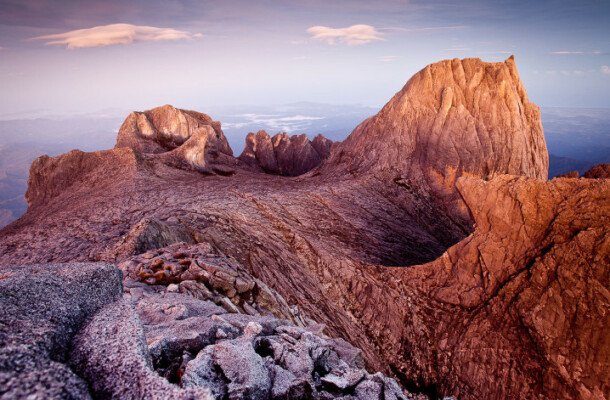Standing majestically in the heart of Borneo, Mount Kinabalu is not just a mountain; it’s a geological masterpiece waiting to be discovered. Join us on an awe-inspiring journey as we peel back the layers of time and delve into the captivating geology of Mount Kinabalu. From ancient origins to the forces that have shaped it, this is a story etched in stone.

A Monument of Granite
Granite Giants
Mount Kinabalu is predominantly composed of granite, an igneous rock formed deep beneath the Earth’s surface. This resilient rock type gives the mountain its rugged character and enduring stature. Over millions of years, geological forces pushed this granite upwards, creating the iconic peak we see today.
The Power of Plate Tectonics
The geological magic of Mount Kinabalu traces back to the collision of tectonic plates. The mountain is part of the Crocker Range, a result of the Eurasian Plate’s collision with the Sunda Plate. This monumental tectonic clash propelled the granite skyward, forming the backbone of Borneo.
Ancient Coral Reefs on High
Fossilized Treasures
One of the most astonishing geological aspects of Mount Kinabalu is the presence of fossilized coral reefs near its summit. These ancient remnants are a testament to the mountain’s past life beneath the sea. Millions of years ago, the region was submerged, and coral reefs thrived. Today, their fossilized remains tell a tale of underwater worlds long gone.
The process of how these coral reefs ascended to over 4,000 meters above sea level is an extraordinary geological journey. As tectonic forces pushed the landmass upwards, the coral reefs rode this geological elevator, eventually becoming part of the mountain’s geological makeup.
The Forces of Weathering and Erosion
Weathering Wonders
Mount Kinabalu’s jagged peaks are not only a result of geological processes but also the relentless forces of weathering. Rain, wind, and temperature fluctuations play their part in sculpting the mountain’s rugged features. Over eons, these processes have chiseled the granite into spires, pinnacles, and ridges that define its distinctive silhouette.
The Role of Glaciers
In the distant past, Mount Kinabalu was home to glaciers during the last ice age. These frozen giants had a hand in shaping the landscape we see today. As glaciers flowed and retreated, they carved out valleys and hollows, leaving their mark on the mountain’s geological history.
The Rainbow of Rocks
While granite forms the mountain’s core, Mount Kinabalu is also a treasure trove of geological diversity. It’s a palette of rocks, each with its own unique color and composition. From the vibrant reds of rhyolite to the dark hues of basalt, the geological spectrum of Mount Kinabalu is a sight to behold.
The Kinabalu Park’s Geological Showcase:
Adjacent to the mountain, Kinabalu Park offers an accessible window into this geological wonderland. Visitors can explore an array of rock formations and discover the rich diversity of minerals that have shaped the region over millennia.
The Kinabalu Fault Zone
The Kinabalu Fault Zone, a prominent geological feature, runs along the western side of Mount Kinabalu. It’s a site of intense geological activity, where tectonic forces continue to shape the landscape. The fault zone is a stark reminder of the Earth’s ever-evolving nature.
Hot Springs and Thermal Springs
One fascinating outcome of the Kinabalu Fault Zone is the presence of hot springs and thermal springs in the region. They provide a soothing respite for weary travelers and a glimpse into the mountain’s geothermal heart.
Geological Time Travel
Mount Kinabalu is like a geological history book, with each layer of rock telling a story of the Earth’s past. Geologists can trace the mountain’s evolution by examining these layers, deciphering the ancient environments, and uncovering the mysteries of its formation.
The geological timeline of Mount Kinabalu spans millions of years. From the birth of the granite beneath the Earth’s surface to its ascent through tectonic forces, the mountain’s history is a testament to the immense scale of geological time.
Geological Conservation
The unique geological features of Mount Kinabalu, from its granite core to its fossilized coral reefs, make it a natural treasure. Conservation efforts are vital to protect these geological wonders for future generations. Kinabalu Park and UNESCO World Heritage status ensure the preservation of this geological gem.
Conclusion
As we conclude our journey through the geology of Mount Kinabalu, we’re left with a profound appreciation for the Earth’s geological wonders. This majestic mountain, with its granite core, fossilized reefs, and ever-changing landscape, reminds us of the forces that have shaped our planet over eons. Mount Kinabalu is not just a mountain; it’s a geological masterpiece, inviting us to connect with the Earth’s ancient history and embrace the marvels of our natural world.




